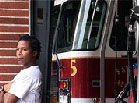
Some Real Heat 2001
Distributed by Women Make Movies, 462 Broadway, New York, NY 10013; 212-925-0606
Produced by Stefanie Jordan
Directed by Stefanie Jordan
VHS, color, 54 min.
College - Adult
Gay and Lesbian Studies, Women's Studies
Date Entered: 01/19/2004
Reviewed by Faye Chadwell, University of Oregon Library System, Eugene, ORSome Real Heat focuses on the women firefighters employed within the San Francisco Fire Department, a department boasting the highest percentage of women in its ranks within the United States. Predictably these women speak of the hostility they have experienced in this male-dominated profession during both training and on the job. They discuss the public misperception of female firefighters and talk about being role models for America's youth, especially for children of color.
The topics of danger and death are also frequently discussed, though 80 percent of the calls are medical responses rather than calls for fires. The camera follows these workers on several calls, conveying a realistic sense of the danger these women face. But the coverage never stoops to sensationalist shots with gory and gruesome details. One of the documentary's most harrowing moments is retired firefighter Mel Stapper's account of a small fire that transformed into a big blaze, claiming her captain's life and yielding third degree burns over much of her body.
Some Real Heat is German filmmaker Stefanie Jordan's first documentary. While Jordan presents these seven San Francisco women firefighters as brave role models for both girls and boys, she also lets them impart how they cope with and express their personal vulnerabilities and fears in ways that often differ from their male co-workers. One of the women describes the profundity of being with another human being on the last day of that person's life. She describes how each encounter with death generates a moment of clarity for her.
Because each firefighter must be able to carry 100 pounds of equipment, they all strive to remain in optimal physical shape in order to be prepared. Jordan does an amazing job of capturing the physical demands of this labor, closely shooting one firefighter's weight workout. She also lets the women describe her personal relationship with the tools of the trade (axes, chainsaws, and even the fire truck itself), descriptions that seem almost sexual and certainly reverent.
Jordan's earlier works have included commercials, the animated short Late at Night (1997) and two black and white shorts, Crude (1996) and Me and Mrs. Jones (1994).
Overall, this documentary could prove life-affirming for the girl or young woman who wanted to pursue one of the most dangerous professions in the United States. This film is recommended for high school and college/university level classes.